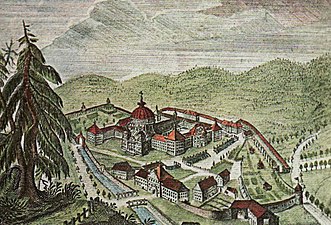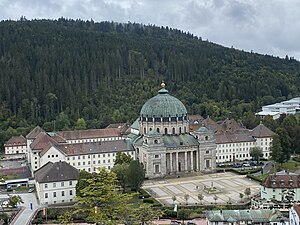Saint Blaise Abbey, Black Forest

Saint Blaise Abbey (
History
9th–12th centuries
The early history of the abbey is obscure. Its predecessor in the 9th century is supposed to have been a cell of Rheinau Abbey, known as cella alba (the "white cell"), but the line of development between that and the confirmed existence of St Blaise's Abbey in the 11th century is unclear. At some point the new foundation would have had to become independent of Rheinau, in which process the shadowy Reginbert of Seldenbüren (died about 962), traditionally named as the founder, may have played some role. The first definite abbot of St Blaise however was Werner I (1045?–1069). On 8 June 1065 the abbey received a grant of immunity from Emperor Henry IV, although it had connections to the family of the anti-king Rudolf of Rheinfelden.
Between 1070 and 1073 there seem to have been contacts between St. Blaise and the active
During the course of the 12th century however the zeal of the monks cooled, as their attention became increasingly focussed on the acquisition, management and exploitation of their substantial estates, which by the 15th century extended across the whole of the Black Forest and included not only the abbey's priories named above, but also the nunnery at Gutnau and the livings of Niederrotweil, Schluchsee, Wettelbrunn, Achdorf, Hochemmingen, Todtnau, Efringen, Schönau, Wangen, Plochingen, Nassenbeuren and many others.[1]
13th–17th centuries
The original
From the mid-13th century the Vögte (protective lordship) were
17th century – present
The abbey was dissolved in the course of secularisation in 1806 and the monastic premises were thereupon used as one of the earliest mechanised factories in Germany. The monks however, under the last Prince-Abbot Dr Berthold Rottler, found their way to
From 1934, the remaining buildings have been occupied by the well-known
St Blaise's "Cathedral"
The abbey church burnt down in 1768, and was rebuilt as a Neoclassical round church by the architect Pierre Michel d'Ixnard, with an enormous dome 46 metres across and 63 metres high (the third-largest in Europe north of the Alps), during the years up to 1781 under the Prince-Abbot Martin Gerbert. It was consecrated in 1784.[3]
It remains as the Dom St Blasius, or "St Blaise's Cathedral" (so called because of its size and magnificence, not because it is a cathedral in any ecclesiastical or administrative sense). Dom properly denotes or means an important church (as the main church of a town or a city), not a cathedral (seat of a bishop), Kathedrale in German. The effects of another catastrophic fire in 1874 were only finally remedied in the 1980s.
Gallery
- Sankt Blasien
-
Painting of the Abbey, 1783
-
St Blaise Abbey
-
Front of the Abbey
-
The Abbey Dome
Abbots of St. Blaise in the Black Forest
- Beringer von Hohenschwanden (945-974)
- Ifo (974-983)
- Siegfried (983-1021)
- Bernard (1021–1045)
- Werner I (1045–1069)
- Giselbert (1068–1086)
- Otto I (1086–1108)
- Rustenus (1108–1125)
- Berthold I (1125–1141)
- Gunther of Andlau (1141–1170?)
- Werner II of Küssaberg (1170–1178)
- Theodebert of Bussnang (1178–1186)
- Manegold of Hallwil (1186–1204)
- Hermann I of Messkirch (1204–1222)
- Otto II (1222–1223)
- Hermann II (1223–1237)
- Heinrich I (1237–1240)
- Arnold I (1240–1247)
- Arnold II (1247–1276)
- Heinrich II of Stadion (1276–1294)
- Berthold II (1294–1308)
- Heinrich III (1308–1314)
- Ulrich (1314–1334)
- Petrus I of Thayingen (1334–1348)
- Heinrich IV of Eschenz (1348–1391)
- Konrad (1391)
- Johannes I Kreutz (1391–1413)
- Johannes II Duttlinger (1413–1429)
- Nikolaus Stocker (1429–1460)
- Petrus II Bösch (1460–1461)
- Christopher of Greuth (1461–1482)
- Eberhard von Reischach (1482–1491)
- Blasius I Wambach (1491–1493)
- Georg (Buob?) of Horb (1493–1519) Buob
- Johannes III Spielmann (1519–1532)
- Gallus Haas (1532–1540)
- Johannes IV Wagner (1540–1541)
- Caspar I Müller von Schöneck (1541–1571)
- Caspar II Thomae (1571–1596)
- Martin I Meister (1596–1625)
- Blasius II Münster (1625–1638)
- Franz I Chullots (1638–1664)
- Otto III Kübler (1664–1672)
- Romanus Vogler (1672–1695)
- Augustin Simon Eusebius Finck (1695–1720)
- Blasius III Bender (1720–1727)
- Franz II Schächtelin (1727–1747)
- Coelestin Vogler (1747–1749)
- Meinrad Troger (1749–1764)
- Martin II Gerbert (1764–1793)
- Moritz Ribbele (1793–1801)
- Berthold III Rottler (1801–1806)
Burials
Footnotes
- ^ Dom St. Blaise. Zur Geschichte des Doms.
- ^ Dom St. Blaise. Zur Geschichte des Doms.
- ^ Johann Baptist Weiß Festrede, gehalten am 8. Tage der Feierlichkeiten bei Einweihung der neuen Kirche zu St. Blasien. St. Gallen, 1784 (Official speech given on the 8th day of the celebrations for the consecration of the new church at St. Blasien)
Sources
- Braun, J. W. (ed.), 2003. Urkundenbuch des Klosters Sankt Blasien im Schwarzwald. Von den Anfängen bis zum Jahr 1299; Teil I: Edition; Teil II: Einführung, Verzeichnisse, Register (= Veröffentlichungen der Kommission für Geschichtliche Landeskunde in Baden-Württemberg: Reihe A, Quellen; Band 23), Stuttgart. ISBN 3-17-017985-3
- Buhlmann, M., 2004. : Benediktinisches Mönchtum im mittelalterlichen Schwarzwald. Ein Lexikon. Vortrag beim Schwarzwaldverein St. Georgen e.V., St. Georgen im Schwarzwald, 10. November 2004, Teil 2: N-Z (= Vertex Alemanniae, H.10/2), pp. 76ff. St. Georgen.
- Ott, H., 1963. Studien zur Geschichte des Klosters St. Blasien im hohen und späten Mittelalter (= Veröffentlichungen der Kommission für geschichtliche Landeskunde in Baden-Württemberg; Reihe B, Band 27). Stuttgart.
- Ott, H., 1965. Die Vogtei über das Kloster St. Blasien seit dem Aussterben der Zähringer bis zum Übergang an das Haus Habsburg, in: Zeitschrift für die Geschichte des Oberrheins, Band 113 (NF 74), pp. 30–44.
- Ott, H., 1969. Die Klostergrundherrschaft St. Blasien im Mittelalter. Beiträge zur Besitzgeschichte (= Arbeiten zum Historischen Atlas von Südwestdeutschland, Bd.4). Stuttgart.
- Quarthal, F. (ed.), 1987. Germania Benedictina, Bd.5: Die Benediktinerklöster in Baden-Württemberg, 2nd ed., pp. 146–160. St. Ottilien. ISBN 3-88096-605-2




